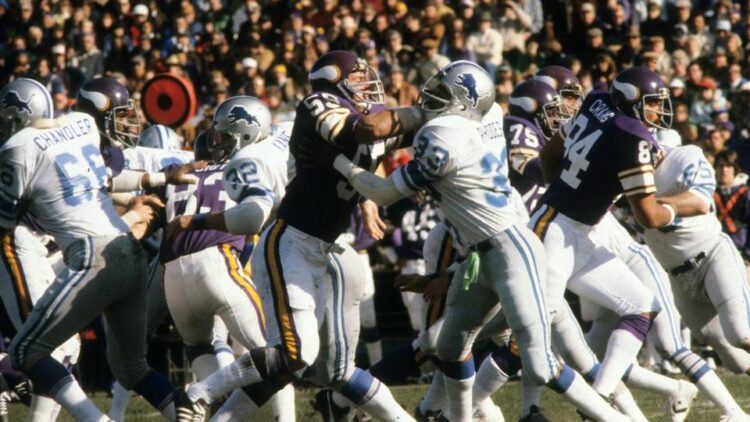Mick Tingelhoff Selected for Hall of Fame

Per Mark Craig, Mick Tingelhoff has been selected to the Hall of Fame.
It’s official: Tingelhoff has been selected to the Hall of Fame.
— Mark Craig (@markcraignfl) February 1, 2015
There’s a lot to say about his HOF case, so, I’ll just copy and paste everything I wrote about Tingelhoff back when he was announced:
Peter King, in his MMQB column, makes Tingelhoff’s case to be in the Hall as well as anyone:
[quote_box_center]
I think I have one name to keep in mind as the Pro Football Hall of Fame senior committee gathers this week in Canton to nominate one old-timer for election to the Pro Football Hall of Fame, class of 2015: Mick Tingelhoff. Think of Tingelhoff’s greatest accomplishment:
For the last 358 games of his 17-year career—99 preseason games, 240 regular-season games, 19 postseason games—Tingelhoff started. He failed to start only once—the first exhibition game of his career for the Vikings in 1962. Amazing. He dressed for 359 games in 17 years, and started the last 358. “He never missed a practice either,’’ his onetime quarterback, Fran Tarkenton, said.
He made first-team All-Pro seven times; no NFL center was voted first-team All-Pro more times. Back when the Pro Bowl meant something, a back playing behind Tingelhoff made the Pro Bowl 13 times.
[/quote_box_center]
Missing in Peter King’s well-argued case is the fact that none of those backs that made the Pro-Bowl behind his blocking were inducted into the Hall of Fame themselves.
The “first-team All-Pro” is a bit, but not entirely, misleading as he made the Associated Press All-Pro five times, but has seven total season recognized as All-Pro by one of the Associated Press, United Press International, Pro Football Weekly and the Pro Football Writer’s Association. These All-Pro recognitions outside of the AP were considered at the time every bit as prestigious.
Every center with four or more AP All-Pro selections is in the Hall of Fame, except Mick Tingelhoff (they are Jim Otto, Bulldog Turner, Dermontti Dawson, Jim Ringo, Mel Hein, Mike Webster, Jim Langer and Dwight Stephenson). Jim Otto’s All-AFL selections are included in Pro-Football-Reference’s AP All-Pro count, which is part of the reason that the generic AP All-Pro award has not been awarded more times to any single center. Also of note, when the All-Pro candidacy was expanded to include the AFL before the merger (1967-1969), Tingelhoff beat out Otto two of three times.
Of the three centers with three All-Pro recognitions, one is in the Hall of Fame (Frank Gatski), one will be (Kevin Mawae) and one only played in the NFL for three years (Clyde Smith).
Tingelhoff’s ironman reputation is powerful and well-worth commendation, but also worth consideration is that he was considered the best center in either league at cutting off the middle linebacker on runs, and played with surprising quickness for quite some time in his career. His quickness was also useful when cross-blocking, a technique which has linemen swap which defenders they’re blocking, creating unique angles in the run game and confusing defensive keys (and it helped Ed White look even better, too). He sustained blocks at the second level better than almost every center in the era and was excellent at blitz pickup.
Further, Tingelhoff was a captain every year Bud Grant was with him and was considered not just a team leader, but an invaluable help on the practice field. His intelligence helped guide the potent Vikings offenses that he played center under.
The knock on Tingelhoff’s career remains the Super Bowl failures of the Vikings, as well as what many perceive to be struggles against larger tackles lined up over the center, like Joe Greene, Curley Culp and Buck Buchanan. While Jim Otto had similar struggles (and more consistently) against these defensive tackles, he doesn’t have this knock on his career, perhaps because Tingelhoff’s worst performances against these players happened to occur in the few Super Bowl meetings, despite good performances against them in the regular season.
Without much national exposure (true of nearly any team outside of teams with “national appeal,” like the Pittsburgh Steelers, Dallas Cowboys and Oakland Raiders), his performance in one or two games may have overshadowed his far superior performances against these same players on a more consistent basis. It didn’t help that he wasn’t as large as the new generation of centers entering the league as a result of defensive changes. It’s somewhat of an unfair burden, as centers in the 1960s were selected for their agility and ability to match up against middle linebackers, but over- and under-shifted fronts in the 1970s encouraged defensive tackles to attack the center directly, as they stopped lining up over guards directly. That said, he was far better than his reputation at this responsibility.
It also doesn’t help that Tingelhoff’s career looks inconsistent when gazing back into history. A six-time All-Pro offensive linemen would likely make the hall with a nine or ten year career, but not when you add seven more years onto it for reasons that have more to do with the flaws of human cognition than they do rational sense.
I’m glad that Tingelhoff made it in. He deserves it.
